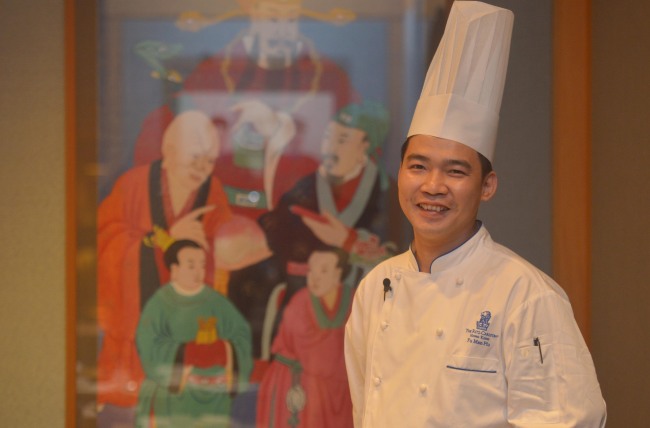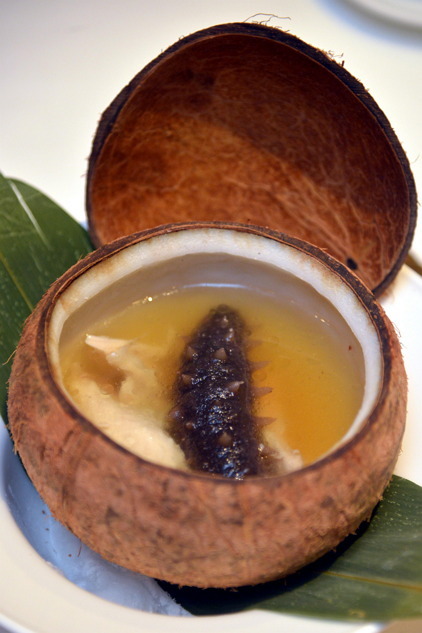Cantonese cuisine in Seoul from Michelin-starred chef
Tin Lung Heen sous chef Fu Man Piu in town
By Korea HeraldPublished : May 23, 2014 - 19:41
Fu Man Piu, sous chef of The Ritz-Carlton Hong Kong’s two Michelin-starred Tin Lung Heen, set foot for the first time in South Korea on Tuesday to showcase Cantonese cuisine at the JW Marriott Seoul as part of its second annual Culinary Art Event.
Fu is presenting two prix fixe menus that he says he has culled directly from Tin Lung Heen’s famed repertoire, giving diners in Seoul an opportunity to taste the cuisine that helped earn the restaurant two much-coveted stars.
While Tin Lung Heen chef de cuisine Paul Lau will not be attending the event, Fu revealed that dim sum specialist Yuen Kwok Hung has accompanied him to Seoul to craft some of the delicious dishes being served for 10 days at JW Marriott’s Man Ho.
“Dim sum plays a central role in Cantonese cuisine,” said Fu, 40, of the delicate array of delights like har gow (shrimp dumplings) that are often carted from table to table on trolleys. “One cannot have Cantonese cuisine without dim sum.”
Fu is presenting two prix fixe menus that he says he has culled directly from Tin Lung Heen’s famed repertoire, giving diners in Seoul an opportunity to taste the cuisine that helped earn the restaurant two much-coveted stars.
While Tin Lung Heen chef de cuisine Paul Lau will not be attending the event, Fu revealed that dim sum specialist Yuen Kwok Hung has accompanied him to Seoul to craft some of the delicious dishes being served for 10 days at JW Marriott’s Man Ho.
“Dim sum plays a central role in Cantonese cuisine,” said Fu, 40, of the delicate array of delights like har gow (shrimp dumplings) that are often carted from table to table on trolleys. “One cannot have Cantonese cuisine without dim sum.”

With this in mind, Fu has enlisted Yuen Kwok Hung to showcase pork and shrimp dumplings with caviar and baked abalone puffs with minced chicken at Man Ho.
While Tin Lung Heen’s much-talked-about Iberian pork char siu ― barbecue pork ― will not be on the menu, Fu says one can look forward to Wagyu beef with garlic and sauteed lobster with scallops and scallions.
The Wagyu dish sends a nod to what has arguably become the trademark style of Tin Lung Heen, which Fu explained as using high-quality ingredients like Iberian pork and Wagyu to create traditional Cantonese fare.
“We use it because the meat is tender,” Fu said, stressing that the use of such internationally recognized ingredients is all about quality.
As for the stars, Fu believes Tin Lung Heen earned them for its service, ambience and novel, unique fare like the popular Iberian pork char siu.
“You need that one special dish,” he explained.
Perhaps another key to Tin Lung Heen’s success is the teamwork that goes on behind the scenes.
Fu praised executive chef Lau, saying, “He does not know how to give up on something.”
Of working with him, Fu added, “He will look at an ingredient and then discuss what to do with the team.”
Lau expressed the same depth of admiration for sous chef Fu, writing via email of how he knew he wanted to train Fu as his protege when he first met the talented chef at The Peninsula Hong Kong over four years ago.
Fu, who was born in Hong Kong, seemed destined for chefdom at birth.
He revealed that both his father and uncle were chefs and Fu himself started to cook when he was a teenager, working part-time at his father’s establishment.

Specializing solely in Cantonese cuisine, which hails from China’s Guangdong province, Fu revealed he is particularly skilled with seafood.
As he explained what differentiates Cantonese fare from other Chinese regional cuisines, he started off by pointing out that the linchpin of Cantonese cooking is in the emphasis on fresh ingredients to achieve an ideal balance of flavor and fragrance.
“We only use live fish, especially when serving it steamed,” Fu explained, referring to, it seems, the famed steamed fish of Cantonese cuisine, where it is often served up firm, fragrant and topped with silken threads of scallions, aromatic cilantro and slivers of ginger.
Fragrance was a concept he returned to again and again. By fragrance he seemed to mean the aromas of the produce and meat itself, unearthed by the simple and straightforward heat of the flame as with, for instance, the sauteed lobster he serves at Man Ho.
“When sauteed, the lobster has chew and is fragrant,” he said.
Fu explained how Cantonese cooking often requires stir-frying ingredients quickly at high heat to achieve optimal aromas and sweetness of flavor, adding that one of the tests of a true chef of Cantonese cuisine can be judged by stir-fried vegetables.
“You can see how well the chef rolls the wok and brings out the fragrance of the dish,” he explained.
“Cantonese cuisine is about being tasty, using fresh ingredients and making it aromatic,” Fu said. “The harmony of these is most important.”
By Jean Oh (oh_jean@heraldcorp.com)
-
Articles by Korea Herald







![[Weekender] How DDP emerged as an icon of Seoul](http://res.heraldm.com/phpwas/restmb_idxmake.php?idx=644&simg=/content/image/2024/04/25/20240425050915_0.jpg&u=)



![[KH Explains] No more 'Michael' at Kakao Games](http://res.heraldm.com/phpwas/restmb_idxmake.php?idx=644&simg=/content/image/2024/04/28/20240428050183_0.jpg&u=20240428180321)







![[Herald Interview] Mistakes turn into blessings in street performance, director says](http://res.heraldm.com/phpwas/restmb_idxmake.php?idx=652&simg=/content/image/2024/04/28/20240428050150_0.jpg&u=20240428174656)
